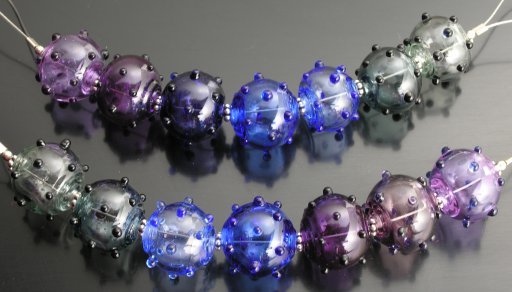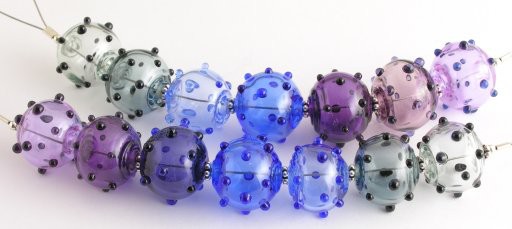People just never respond the way you expect them to, which is one of the reasons interacting with them is so much fun. For example, when I originally came up with this idea of graduated dotties, I was certain Page would be absolutely fascinated by them because she has such a classic sense of design. And what could be more classic than a series of seven symmetrical beads, all the same size and style, with only slight differences in color? And she does like them, and thinks they're beautiful.

2 series of graduated color dotties. Hollow, of assorted soda-lime glasses, measuring approximately 13mm each; January 2007.
However, the beads she's most interested in making herself are pixie snailshells. Go figure.
Or maybe it means I do have a sense of design, not just a tendancy to create color and texture with wild, undiciplined abandon. (In fact, Page's classicism is engaged by bubble beads, which are basically pixies without the coating. But that's a post for another time...;)
I usually break new ground by fooling around with scraps, but I'm attempting to develop other ways of (gag) “exploring my creativity” (i.e. generating new ideas) and one way to do this is to set formal problems. The last one I actively recall was attempting to mix transparent amethyst with fuschia and amber crystals/beads, which since I hadn't even started making beads, was probably 15 years ago.
What was I saying about discipline, again?
Anyway. I've been thinking for awhile that it would be good if I could reliably create calibrated sizes of beads, especially dotties. By the time I finished the new sample strings, as well as these series, I was getting sort of decent at it. I should note, for all you solid bead folk out there, that a 13mm hollow expands a good deal—something upwards of 2mm, I'd say—during the puffing process; then of course it contracts again, most notably between, say 1400 and 1000 degrees F.
This makes sizing a little tricky, as you kind of have to predict what will happen, just as all lampworkers have to predict color molten glass will be once it cools. Not saying it can't be learned of course. But I haven't gotten particularly reliable at it, and I've been doing this for awhile.
Friends are Unreasonable Unpredictable, Part II.
I'm privileged that Kristin Perkins has me photograph a lot of her jewelry, and on many fronts we agree; however, she prefers the look of her stuff photographed on white.
I hate photographing on white.
There are several reasons for this, and all of them are embarressingly easy to remedy, as the picture below proves. One is to shoot on a matte white surface, i.e. sand the white plexi I have. That eliminates the faint and unattractive colored reflections which compete with the shadows. (On black, the two usually are one and the same, so it's not a problem.)
Another is to think objectively about what sorts of things look good on white. Hint: cameras do not have the dynamic range of the human eye, that is, they can't perceive the same spread of values. —That's right, really pale transparents look good on white. Stronger colors look good on black. Just about everything shows up on 18% grey, though it's kind of a bland surface.
So after quite unfairly haranging poor Kristin about shooting on white, and being hoist on my own petard with some of her beads made mostly out of clear colorless glass (which really doesn't do well on black) I shot some of her stuff on white.
It looked stunning, naturally.
And it occurred to me that maybe shooting on white would solve the nasty reflections I was getting all over the dotties.
And what do you know? There are still a number of untidy reflections, but overall, I think this is a much more successful image. Only problem is, the camera's autofocus, which has a difficult enough time with light bouncing about inside of glass beads, works even less well with white backgrounds. And the manual focus is useless with the macro setting.
I suppose this means I need to upgrade to an SLR, with the kind of lovely manual focus my vivitar macro lens has. Preferably with autofocus backup...I did say the problems were easy to fix, just not necessarily cheap to fix.
*Yes, the price basically doubles for calibrated sizes. Currently only available as a special order. Specify a color [range]. Available in either 10 or 13mm. Allow 2–4 weeks for delivery.
file created 17jan07.
Unless otherwise noted, text, image and objects depicted therein copyright 1996--present sylvus tarn.
Sylvus Tarn